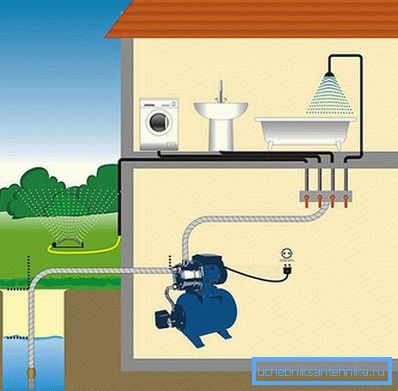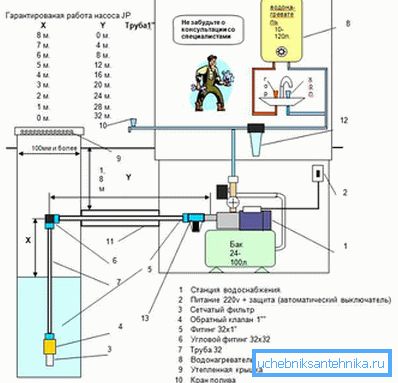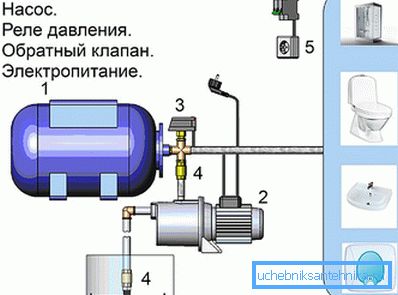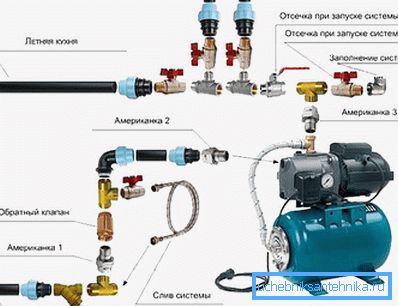Connecting the pumping station to the well
The provision of engineering communications of suburban settlements is a problem point in most territories. Centralized water supply, water disposal, heating is possible only in suburban settlements adjacent to megalopolises. The solution to the problem of providing the population with water is in the hands of the citizens themselves, who organize autonomous sources of water supply in their area. This may be a well, a well on the first aquifers, an artesian well to water-resistant horizons.
Removing water from the well with the help of buckets is quite a laborious process. The ability to connect various technical means allows not only to mechanize, but also to fully automate the process of supplying water to the house.
To automate the process of water supply, it is necessary to connect the pumping station to the well.
Elements of the pumping station
Autonomous pumping station consists of the following elements:
- self-priming centrifugal pump that provides water from the well to the required height;
- a hydroaccumulator, which provides for the softening of a hydraulic shock, maintaining pressure in the pipeline (it is a container with a membrane and a pneumatic valve for air injection);
- pipes and pipeline fittings and connecting elements;
- shut-off and control elements (valves, pressure gauges, pressure switches, check valves, etc.);
- coarse and fine filters.
Principle of operation
The general scheme of connecting the pump station is shown in the figure. From the well, the suction pipe goes to the pumping station. At the end of the pipeline in the well is a non-return valve with a strainer. Valves and a coarse filter are installed in front of the pumping station. At the outlet of the station set pressure gauge, check valve, fine filter. Further along the pressure pipeline, the water flows to consumers.
The pipeline from the well pump begins to pump water into the accumulator. Filling it to a certain pressure, the pump shuts off. When you open the tap water under pressure enters the mixer, shower and other points of water consumption. When the pressure drops, the pump turns on and starts pumping water from the well back into the hydraulic accumulator. Thus, when regulating the pressure in the system, the pump either works when water is consumed, or is turned off when all consumers of water are shut off.
Location of the pumping station
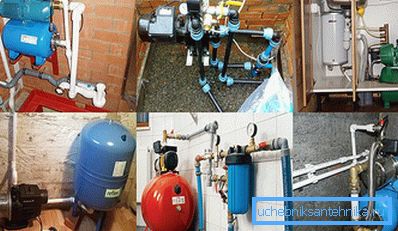
Before installing the station should determine its location. The pumping station should be close to the well. The pipeline from the well to the house should be laid below the level of soil freezing with insulation and protection from frost heaving. Accommodation options:
- Special utility heated space: separate barn, utility room in the house or in the basement of the house. The most preferred option, as it allows at any time to carry out maintenance of equipment in a warm room.
- In the caisson, which is a protective well, located below the level of soil freezing. This option is less common. The caisson is insulated to avoid freezing of the soil in extreme cold, to prevent freezing, damage and failure of all expensive equipment.
Station mounting

With self-installation, you need to know how to connect the station. Reliability and service life of the water supply system depends on the correct installation.
- Installation of pumping station. It can be installed on the L-shaped bracket fixed on the wall of the room, a special podium on the floor where the station is located. The station is positioned, focusing on the direction of the pipeline to the well, so that there are no unnecessary bends. The station should not be in contact with the wall. Rubber pads can be installed under the paws of the station to eliminate vibration noise during operation.
- Installation of the entrance to the station. Through adapters to the inlet in the station, a coarse filter is installed, a check valve, stop valves, and a coupling for switching to a plastic pipeline.
- Installation of the suction pipe. At the end of the pipeline, which is located in the well, a metal mesh and a check valve are installed. To lay the pipeline, a trench is dug to the depth of frost penetration, in which the water supply is laid. The pipes are laid on a sand cushion and covered with sand. With a large depth of frost penetration, the pipeline is insulated. Pipes lead into the house and attached to the adapter coupling.
- Installation of the output pipeline. The flexible hose from the accumulator is connected to a pressure switch. At the outlet, rigid pipes are attached to the fine filter, check valve, stop valves, couplings for the pressure pipe in the house.
Before a test run, water is poured into the pumping station. This is necessary in order to prevent the pump idling.
The pump is connected to the mains and run. All locking elements must be open. All connections are checked for leaks.
Video
Listen to recommendations for choosing a pumping station:
See how the water pump is installed:
Scheme
